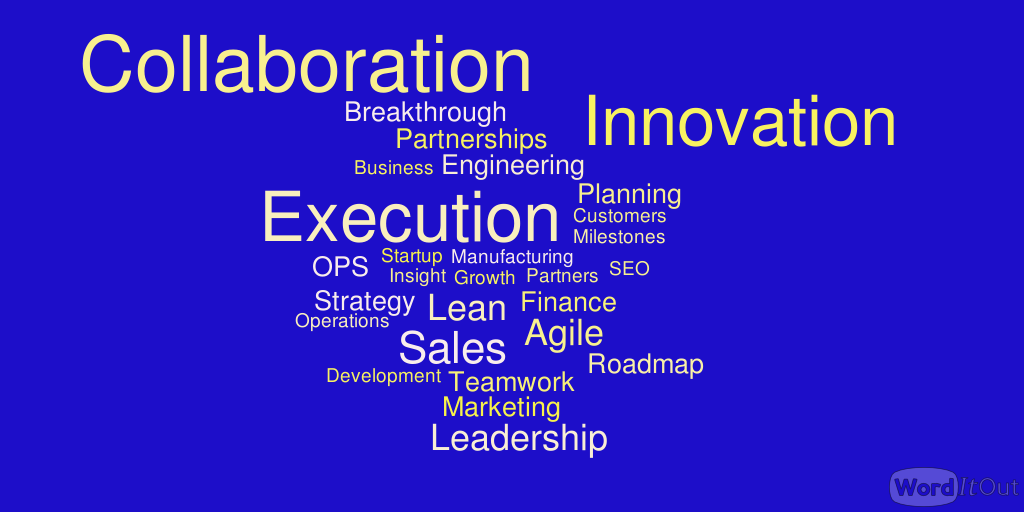 No matter how much we may want to focus and simplify business transformation tactics, leading teams to new levels of success is a multi-dimensional effort. Winning in your market requires a clear knowledge of the market, a solid vision for success and a strategy to create meaningful differentiation for your business platform. You and your team must effectivity develop and position your products, services or applications in ways that appeal to your customers. And at the heart of making this happen is not only the CEO or GM’s leadership, but also the concerted leadership of all key business stakeholders.
No matter how much we may want to focus and simplify business transformation tactics, leading teams to new levels of success is a multi-dimensional effort. Winning in your market requires a clear knowledge of the market, a solid vision for success and a strategy to create meaningful differentiation for your business platform. You and your team must effectivity develop and position your products, services or applications in ways that appeal to your customers. And at the heart of making this happen is not only the CEO or GM’s leadership, but also the concerted leadership of all key business stakeholders.
Much of my recent work has been in “turn-arounds” and “turn-ups” for companies that, once established, ran into some kind of roadblock. Turn-around actions are about fixing what is broken with products, paths to market, quality, service, operations or other core capabilities and regaining momentum. The phase 2 of this is the even more exciting “turn-up” activity. The turn-up is a set of actions that broadens the appeal of the business to existing customers and expands the value that you deliver to the broader market. When I have been asked for a formula for success, I have initially listed a subset of the activities that we went through to make each transformation work, but these “recipes” have never really felt satisfying, complete, or real.
I have come to realize that this is because the dynamics of each turn-around are so different: the issues, competitive challenges, problems in execution and business priorities depend on subjective elements specific to the situation. In short, the cure is always unique. The tools and methods that are perfect for one effort may be irrelevant or even counter productive in another. So if the recipe is situational, how do you figure out what focus, what tools, what priorities and what actions will get you back on solid footing and position you to then drive meaningful growth?
Of course, some things are givens. To be successful, we all know that we need to build products that customers want. We know that we need to sell more volume and at attractive margins. We know that we need to out-maneuver our competition and perform our operations efficiently. But how do we formulate our vision, build our strategy, set the priorities and shortlist actions to get results?
While there are many best practices methodologies and tools to use in managing our businesses, we still need a something to guide our thinking and focus our efforts. We need to use strategic management tools, Agile development methods, Lean manufacturing in operations and all of the rest. But we also need a framework for discovery that will guide our way and help us understand – for each situation – what we should focus on.
After reflecting on what has guided repeated success, the compass I use in business transformations comes to this:
- Collaboration: First you need to understand. What do the different business experts already know? What are the leadership team’s core beliefs? What do the engineers believe is the secret sauce or competitive advantage? What do customers say? What about industry luminaries? What does the competition believe? How sophisticated is the dialogue around this learning and understanding? What can you better understand about strategic growth opportunities and also about risks, gaps and constraints? Teams are smarter than individuals, but only when they work together. With strong leadership, communication and engagement, you can emphasize strengths, synthesize breakthrough ideas and illuminate weaknesses and false assumptions. Through a cycle of managed collaboration you find the genius of the team and build momentum.
- Innovation: The jump off point for your journey into innovation is your learning from collaboration. Within the constraints of cost, talent, time horizons and competition, what innovation will you drive to create a sufficiently differentiated and compelling business advantage? And innovation takes all forms. Product differentiation, services, delivery models, cost management, quality, cost of ownership are all innovation opportunities. Without a plan for differentiation, there is no real plan for success. Building a customer centric culture of innovation sets your business apart.
- Execution: This is all about making it happen. It does not matter how smart and creative your insight from collaboration is or your plans for differentiation are if you and your team do not execute. Realizing your plan requires determination, coordinated effort and leadership. Good execution requires no-nonsense and useful business tracking metrics and the use of best practices in development, marketing, operations and sales, and constant organizational learning. Great execution depends on goal alignment, team motivation and empowerment and requires serious attention to talent acquisition, employee growth and retention.
- Leadership: This is the catalyst and the glue. Leadership must foster more leadership. Leaders should strive for legitimacy through continuous learning, awareness of changing dynamics and by walking the talk. Strong leadershipwill motivate, communicate and empower, and err on the side of action.
With this guide to success, Collaboration, Innovation and Execution are like spheres of the brain or a set of business senses. Like your senses, you don’t stop seeing when you want to hear or touch something. You use all of your senses at once to learn, to understand your environment and to continue to grow your strengths and capabilities. And you learn to walk before you run. The same is true of this business advancement model.
Collaboration, Innovation and Execution activities are iterative and never-ending. You execute a discovery, learning and synthesis cycle and then set your direction, establish goals, drive to milestones and deliver on objectives. But do this using an Agile approach and with mindfulness of the need for continuous learning in your dynamic and evolving situation. Collaborate, state your assumptions, get feedback and try it again. Continue to tune your goals for innovation and and how you will improve cross functional execution. Test your assumptions against real customer needs and wants. Is the value you deliver important and essential? Innovate more and push your value delivery further into the “must-have” category for your customers.
This continuous cycle applies to product, sales methods, marketing approaches, operations, customer engagement, price, place, promotion and everything else, but all within a mindset of prioritization and operating within your real business constraints. Beginning with the first efforts of a turn-around, and expanding the scope through expansion in a dynamic business turn-up, Collaboration, Innovation and Execution drive your momentum, inform your strategy and tactics and glue your teams together.
Please watch for further updates on this business management framework. I am looking forward to further developing this model and calling out the underlying tools and methods that sharpen each of the “senses” of Collaboration, Innovation and Execution.







Leave A Comment